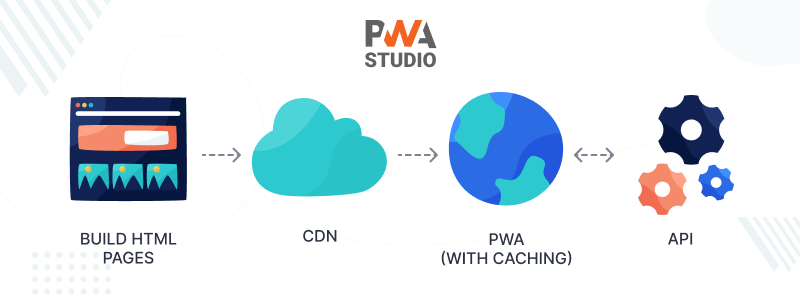
The year is 2022, and it is the month of January. A new decade has arrived, along with a digital era characterized by rapid growth in eCommerce.
New ideas, opportunities, markets, and selling points emerge at a breakneck pace, and it’s up to you as a business to keep up.
Only one option exists if you want to compete in this fast, ever-changing market: your software must be extendable, maintainable, reliable, scalable, and flexible.
Headless commerce is the solution that breaks down monoliths into smaller, more agile parts that communicate via API.
SSR is a vital part of headless development because, in order to fetch the content generated by the API, SSR uses a Node.js front-end server.
Evolution of Headless
Ecommerce systems were formerly established in a monolithic fashion at the beginning of the twenty-first century.
You normally bought an all-in-one solution off the shelf if you wanted to start an internet store.
Of course, with the help of your software engineers, you could customize it on your own. However, an all-in-one strategy does not always work in eCommerce.
It’s a customized process that is crucial to your competitive advantage. Moreover, All of this necessitates ongoing adjusting and upgrading.
Headless commerce architecture solves this challenge by breaking down monoliths into smaller, more agile parts that communicate via API.
What is Monolith?
The term “monolith” refers to a structure that is made entirely of one component.
A monolithic software application is a single-tiered software application that combines multiple components into a single program on a single platform.
Example
Consider an eCommerce application that allows customers, accepts orders, checks product inventories authorizes payment, and ships the products ordered.
This application comprises components, including an e-Store User Interface for customers, as well as backend services for checking products, authorizing and charging payments, and shipping orders.
Despite the fact that the application has multiple components, it is created and deployed as a single application for all platforms i.e. desktop, mobile, and tablet.

Drawbacks of Monolith Architecture
Maintenance
It’s difficult to make changes quickly and correctly if the application is too huge and complex to understand completely.
Reliability
Because the processes in a monolith are so interlinked, a problem in one module might bring the entire system down.
Frequently, it isn’t a bug that causes an application to crash, but rather a simple operation that consumes too much memory.
Flexibility
By nature, a monolith creates a barrier to new technology adoption. However, any changes to the framework or language will have an impact on the entire application.
Costly
All modifications to monolith systems take a long time to complete as they must be extensively tested.
Therefore, It takes more effort to ensure that nothing goes wrong, and IT specialists’ time is not cheap.
What do we mean by Microservices?
Microservices is a method of application development in which a large application is composed of a collection of loosely connected modules/components.
Each module serves a distinct business purpose and communicates with other services via a simple, well-defined interface.
Each microservice has its own database, rather than sharing a single database as in a monolithic application.
If you want to take advantage of microservices, then you’ll need a database per service. This ensures loose coupling.
What is Headless?
Headless development means decoupling backend with frontend.
That means the backend is used for API purposes and front development and site rendering run on modern frameworks like Reactjs.
A frontend (or numerous frontends), a backend, and an API as a communication layer in between are the three pillars that make up headless commerce.
This architecture enables the system to be developed at multiple speeds: at the front with rapid design iteration and a field to test new features and at the back with security and stability.
The two sides of the system communicate via API, allowing them to remain separate entities while maintaining data flow.
SSR is a vital part of headless development because, in order to fetch the content generated by the API, SSR uses a Node.js front-end server. Following that, it generates HTML and transmits it to the browser.

Why we should adopt Headless?
Improved Speed
Headless websites are faster than traditional websites since changes on the frontend do not necessitate modifications on the backend.
Flexibility
Merchants can quickly update their forward-facing content layer without disrupting back-end logic processes, and vice versa, because the front and back end function independently.
Scalability
Front-end developers can operate more efficiently as a result of operating constraints, cutting operating costs, and accelerating site upgrades in less time with fewer resources.
Robust customization
Customer data is available across all touchpoints, allowing retailers to provide customers relevant discounts and offers and create tailored meaningful buying experiences.
Conversion Rate
The goal of headless is to create a unique interface for each device. At the very least, a store rebuilt in this manner has desktop and mobile “heads.”
This enhances the customer experience and, as a result, your conversion rate.
Adaptability
The ability to keep the business infrastructure distinct from the front-end and back-end of the website ensures that the content and functionality of the website remain constant.
Your company can stay competitive by adjusting to changing customer needs.
How to Make your Magento 2 Headless?
You’ll need to update Magento if it’s older than version 2.3. If you’re still using Magento 1, you’ll need to migrate to Magento 2.
Progressive Web Apps(PWA)
Progressive Web Apps are the future of the mobile experience. “A Progressive Web App uses modern web capabilities to deliver an app-like user experience.” – says the PWA Team.
PWA is capable of utilizing native device APIs to deliver a seamless experience to mobile users. It feels like a natural app on the device which lets users access the app with maximum native usability.
PWA is really fast and reliable. PWA has the ability to work on slow internet connections or even when the device is offline.
Modern PWA portable frontends are like native apps in many ways, and their speed benefit is evident as exploring the website is faster—which people do a lot when they are shopping online.
Magento PWA Studio is a set of tools that allows Magento 2 developers to create complex progressive web apps.
It is created specifically for Magento. PWA Studio is only available on Magento 2.3 and higher.
This is completely new, but it’s worth keeping a watch on because it’s clearly endorsed by Magento (with a large community) and is likely to be tightly connected.

Key benefits of using PWA
- Magento 2 websites render more smoothly with a PWA frontend, meaning images do not “bounce around” as they load, even on image-heavy pages.
- The frontend and backend of your store are independent. Hence, It improves the performance and speed of Magento.
- The store offers two frontends, one for desktop and one for mobile. It improves usability, which leads to more conversions.
- PWA’s are easily accessible in poor connectivity.
- The PWA’s are easy to install since the user just has to visit the site and add it to the home screen.
- The Admin can manage or add the banner images, notifications, featured categories, category’s banner images, and icons.
- The product type supported is Simple and Configurable.
Further, for the installation of PWA (PWA Studio) for the Magento 2, please refer to this Blog.
Headless PWA for Magento 2 Create progressive web apps for your Magento store and deliver a mobile app-like experience to your customers.
Magento 2 APIs
API (Application Programming Interface) is the core of any modern infrastructure from the web to mobile, from ERP to CRM. APIs play a very major role.
A headless store uses APIs to connect the frontend and backend eCommerce platforms.
Before going headless, make sure your eCommerce platform has good API coverage and that connecting to a third-party shop is simple.
SOAP and REST endpoints are supported on all Magento versions, and native GraphQL support was enabled with the Magento 2 release.
The GraphQL API can be used to develop PWAs and headless endpoints, although customizing the platform’s code and/or database schema can cause API compatibility issues.
With GraphQL as an alternative to its REST and SOAP web APIs for frontend development, Magento 2 makes it reasonably easy to establish APIs to enable headless websites and PWAs.
We are here to help you in Adopting Headless
Webkul offers headless commerce services built on React, Vue, and their frameworks like Gatsby.js, Next.js, Vue Storefront, Shopify Hydrogen, and Adobe Commerce PWA Studio.
Webkul is one of the largest multi-platform companies. We are working on all the popular e-commerce platforms from Shopify to WooCommerce & from Adobe Commerce to OpenCart.
Not limited to that we are also offering headless commerce development on a range of frontend frameworks.
Conclusion
The world of e-commerce is becoming more demanding, complex, and expanding at an exponential rate.
It is advisable to (re)consider the basics: what is my store, what do I need, what are my goals, and where do I see myself in 5 years?
And that is what next-generation eCommerce should be all about: focusing our resources and attention on what we are strong at, on providing the finest, most innovative experience to our clients, and surprising them time after time by deploying new features quickly while staying ahead of the competition.
Need Support?
Thank You for reading this Blog!
For further more interesting blogs, keep in touch with us. If you need any kind of support, simply raise a ticket at https://webkul.uvdesk.com/en/.
For Magento 2 Elastic search, please follow –
Our Cloudkul Blogs
Elasticsearch, Fluentd, and Kibana (EFK)
Setting up Elasticsearch, Logstash, and Kibana for centralized logging
Managing and Monitoring Magento 2 logs with Kibana
Our store modules –
You may also visit our Magento development services and quality Magento 2 Extensions.
For further help or query, please contact us or raise a ticket.


Be the first to comment.